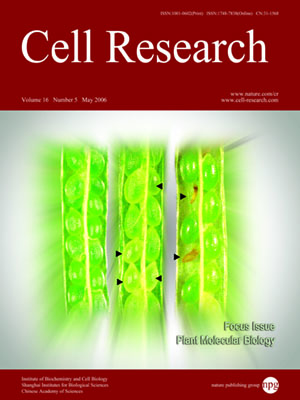
Volume 16, No 5, May 2006
ISSN: 1001-0602
EISSN: 1748-7838 2018
impact factor 17.848*
(Clarivate Analytics, 2019)
Volume 16 Issue 5, May 2006: 479-488
ORIGINAL ARTICLES
Arabidopsis thaliana histone deacetylase 1 (AtHD1) is localized in euchromatic regions and demonstrates histone deacetylase activity in vitro
Paulus M Fong, Lu Tian, Z Jeffrey Chen
1Department of Soil and Crop Sciences, Texas A&M University, College Station, TX 77843, USA; 2Molecular Cell and Developmental Biology, University of Texas at Austin, Austin, TX 78712, USA
Correspondence: Z Jeffrey Chen(zjchen@mail.utexas.edu)
Arabidopsis thaliana histone deacetylase 1 (AtHD1 or AtHDA19), a homolog of yeast RPD3, is a global regulator of many physiological and developmental processes in plants. In spite of the genetic evidence for a role of AtHD1 in plant gene regulation and development, the biochemical and cellular properties of AtHD1 are poorly understood. Here we report cellular localization patterns of AtHD1 in vivo and histone deacetylase activity in vitro. The transient and stable expression of a green fluorescent protein (GFP)-tagged AtHD1 in onion cells and in roots, seeds and leaves of the transgenic Arabidopsis, respectively, revealed that AtHD1 is localized in the nucleus presumably in the euchromatic regions and excluded from the nucleolus. The localization patterns of AtHD1 are different from those of AtHD2 and AtHDA6 that are involved in nucleolus formation and silencing of transgenes and repeated DNA elements, respectively. In addition, a histone deacetylase activity assay showed that the recombinant AtHD1 produced in bacteria demonstrated a specific histone deacetylase activity in vitro. The data suggest that AtHD1 is a nuclear protein and possesses histone deacetylase activities responsible for global transcriptional regulation important to plant growth and development.
Cell Research (2006) 16:479-488. doi:10.1038/sj.cr.7310059; published online 15 May 2006
FULL TEXT | PDF
Browse 1998


